“A man should never give up hope. I’m just so glad to be free. They had said that I was a nobody, a dog, but I stood up and I said the truth. Somebody’s got to do these things in life.”
~Charles Norris … 1976
“Scottsboro Boys”
Before we begin … A few of these “events” are described in somewhat lengthy detail. Considering the circumstances surrounding those events, I felt it was important to do so.

1921 – William Barclay “Bat” Masterson died after a massive heart attack at the age of 67.
Although he was well known as a sheriff and U.S. Marshal in the 1870s, Masterson was a “professional” gambler in the 80s and 90s before spending the final 20 years of his life as a sportswriter.
In fact, Masterson suffered his fatal heart attack while sitting at his desk at the New York Morning Telegraph.
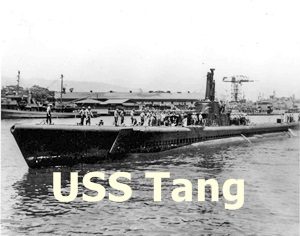
1944 – The USS Tang suffered a very serious disaster due to a malfunctioning torpedo.
A night surface attack by the submarine was launched in the early morning hours against a Japanese transport which had previously been stopped in an earlier attack.
The first torpedo was fired and when it was observed to be running true, the second and last was launched.
It curved sharply to the left, broached and circled. Emergency speed was called for and the rudder was thrown over. These measures resulted in the torpedo striking the stern of the Tang.
The explosion was violent, and people as far forward as the control room received broken limbs. The ship went down by the stern with the three aft compartments flooded.
Of the nine officers and men on the bridge, three were able to swim through the night until picked up eight hours later. One officer escaped from the flooded conning tower, and was rescued with the others.
The submarine came to rest on the bottom at 180 feet, and the men crowded forward as the aft compartments flooded. Thirteen men escaped from the forward torpedo room, but only nine survived.
A total of 78 men were lost.
When the nine survivors were picked up by a Japanese destroyer escort, there were victims of Tang‘s previous attacks on board, and they inflicted brutal torture on the men.
The nine captives were retained by the Japanese in prison camps until the end of the war, and were treated by them in typical fashion.
The loss of the Tang by her own torpedo, the last one fired on the most successful patrol ever made by a U. S. submarine, was a stroke of singular misfortune.
She is credited with having sunk 13 vessels during her final patrol (31 in total) and Commanding Officer Richard Hetherington O’Kane was awarded the Congressional Medal of Honor.
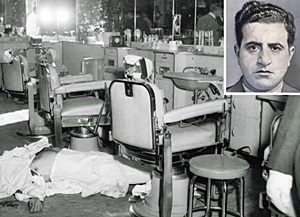
1957 – Mobster Albert Anastasia, the most dangerous and feared hitman of the Cosa Nostra’s “golden era,” died at the age of 55 in a blaze of gunfire.
He was the boss of what became the modern Gambino crime family and is considered by the FBI to be one of the deadliest criminals of all time. His climb up the ranks of the mob left a trail of bodies, including other “bosses” who were killed on Anastasia’s orders.
Eventually it all caught up to him.
On the morning of October 25, Anastasia entered the barber shop of the Park Sheraton Hotel, at 56th Street and 7th Avenue in Midtown Manhattan.
Anastasia’s driver parked the car in an underground garage and then took a walk outside, leaving him unprotected. As Anastasia relaxed in the barber’s chair, two men – scarves covering their faces – rushed in, shoved the barber out of the way, and fired at Anastasia.
After the first volley of bullets, Anastasia allegedly lunged at his killers. However, the stunned Anastasia had actually attacked the gunmen’s reflections in the wall mirror of the barber shop. The gunmen continued firing until Anastasia finally fell dead on the floor.
The homicide sparked a high-profile police investigation but no one was ever charged.
Mob Factoid: The fictional character of Johnny Friendly (played by Lee J. Cobb) in the classic film On The Waterfront was based on Anastasia.
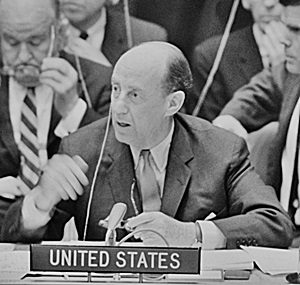
1962 – U.S. ambassador Adlai E. Stevenson had a day no American should ever forget.
President John F. Kennedy had worried that Stevenson – a man with a reputation for preferring to concede than to confront – might not be the right person to present the U.S. position on Cuba forcefully to the world body.
Stevenson showed that he was in fact made of sterner stuff than JFK thought. The former two-time presidential candidate dressed down Valerian Zorin, the Soviet ambassador, in a UN Security Council meeting as Americans watched on television.
But let’s back up for a moment.
Earlier that morning, the State Department handed the Soviet embassy in Washington a letter from Kennedy. It was a response to a letter that Soviet leader Nikita Khrushchev had written the day before.
Whereas Khrushchev’s letter struck an indignant tone, Kennedy’s was cold and to the point: “I regret very much that you still do not appear to understand what it is that has moved us in this matter.”
The final sentence in the letter made it clear that Kennedy wasn’t offering any concessions: “I hope that your Government will take the necessary action to permit a restoration of the earlier situation.”
That afternoon at an emergency meeting of the Security Council, Ambassador Zorin assured his fellow delegates that the Soviet Union had not placed missiles in Cuba.
“Falsity is what the United States has in its hands, false evidence.” The United States, he argued, was manufacturing a threat that could have “catastrophic consequences for the whole world.”
When it was his turn to speak, Stevenson dispensed with the standard diplomatic niceties. He instead went immediately for the jugular:
“I want to say to you, Mr. Zorin, that I do not have your talent for obfuscation, for distortion, for confusing language, and for double talk. And I must confess to you that I am glad that I do not!”
Stevenson went on to denounce the Soviets for lying, treating Zorin in a way that the Soviet ambassador likened to an American prosecutor browbeating a defendant.
Stevenson was just getting started.
“All right, sir, let me ask you one simple question: Do you, Ambassador Zorin, deny that the U.S.S.R. has placed and is placing medium and intermediate-range missiles and sites in Cuba? Yes or no – don’t wait for the translation – yes or no?”
When Zorin refused to answer, Stevenson delivered a remark that will go down in history as one of the most powerful ever made during the Cold War era.
“You can answer yes or no. You have denied they exist. I want to know if I understood you correctly. I am prepared to wait for my answer until hell freezes over, if that’s your decision. And I am also prepared to present the evidence in this room.“
With Zorin still continuing to refuse to answer, Stevenson proceeded to produce large photos of the Soviet missiles in Cuba. The delegates in the room and everyone watching on television saw the Soviets unmasked as liars.
The mild-mannered Stevenson had scored an enormous political and diplomatic victory for the United States.
As dramatic as Stevenson’s tongue-lashing of Zorin was, it did not solve JFK’s fundamental problem – Soviet missiles were in Cuba.
That evening, the president learned from CIA director John McCone that his greatest fear was true: some of the missiles in Cuba were operational.
The stakes were now even greater.
The story continues tomorrow.
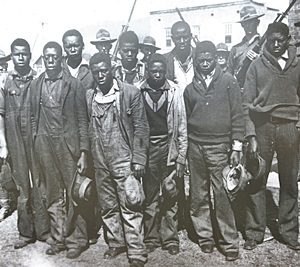
1976 – Alabama Governor George Wallace brought an end to one of the ugliest miscarriages of justice in American history.
Wallace granted a full pardon to Clarence Norris, the last known survivor of the nine “Scottsboro Boys” who were convicted in 1931 of the rape of two white women.
Background: It all began on a train from Chattanooga to Memphis by way of Alabama on March 25, 1931. A white foot stepped on Haywood Patterson’s hand. He shrugged it off, but the harassment continued, and led to a fight between the white and black youths on the train.
After they were thrown off the train, the white boys complained to a stationmaster. When the train stopped in Paint Rock, Alabama, there was a posse waiting. The sheriff’s deputies pulled off nine young African American teenagers and two white women dressed in overalls.
The two women claimed they had been raped. The boys were arrested and brought to the nearest jail … in Scottsboro, Alabama.
A lynch mob gathered outside the jail and threatened to break down the doors. The sheriff called the governor and the governor deployed the National Guard to disperse the mob.
Following an endless series of trials, every single one of the youths were convicted even though one of the women withdrew her accusation.
Clarence Norris, Charlie Weems, Haywood Patterson, Olen Montgomery, Ozie Powell, Willie Roberson, Eugene Williams, and Andy Wright were convicted and given the death sentence.
12-year-old Roy Wright’s trial ended with a hung jury. All the jurors agreed on his guilt, but eleven insisted on the death sentence while one held out for life imprisonment. A mistrial was declared and Wright was sent to prison for life – without a second trial.
Over the next seven years, several of the sentences were reduced to lengthy – in some cases, life – prison sentences.
1937: The state of Alabama dropped all charges against Willie Roberson, Olen Montgomery, Eugene Williams, and Roy Wright. The four had spent over six years in prison on death row.
1941: Charlie Weems was released on parole.
1944: Andy Wright and Clarence were released on parole. Both leave Alabama. This is considered a violation of their parole. Norris returns to jail in October 1944 and Wright in October 1946.
1946: Ozie Powell was released from prison on parole. Norris was again released on parole. He immediately “jumped bail” and went into hiding. In 1976 he was found in Brooklyn, New York.
1948: Haywood Patterson escaped from prison and traveled to Detroit.
1950: Andy Wright was again released on parole. Patterson was caught and arrested by the FBI in Detroit. However, G. Mennen Williams, governor of Michigan refused to extradite Patterson to Alabama.
Six months later, Patterson was charged with murder after a fight in a bar. He was convicted of manslaughter and sentenced to six to fifteen years in prison.
1952: Patterson died of cancer while serving time in prison.
1959: Leroy Wright had joined the army and then the Merchant Marines after his release. Returning home from a tour at sea, he found his wife at the home of another man. In a fit of jealous rage, he killed her and then returned to his apartment and shot himself.
On November 21, 2013 the Alabama Board of Pardons and Paroles unanimously voted to posthumously pardon Charles Weems, Andy Wright, and Haywood Patterson.
They were the last of the nine defendants who hadn’t already been pardoned or had the charges dismissed against them.
The nine Scottsboro Boys spent a total of more than 80 years in prison for the non-existent rapes of the two white girls.
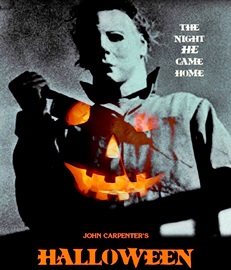
1978 – Halloween, directed by John Carpenter, premiered at the AMC Empire Theatre in Kansas City.
Produced on a budget of only $300,000, the film – which starred Donald Pleasence and Jamie Lee Curtis in her film debut – grossed $70 million worldwide, becoming one of the most profitable independent films ever made.
It also spawned a series of eight sequels but if you haven’t had enough, there’s good news for you.
In July 2019, the titles and release dates of two more sequels were announced: Halloween Kills, set to be released on October 16, 2020, and Halloween Ends, set to be released on October 15, 2021.
Idle Thought: I’ll be skipping the next two … which will keep my record of never having seen one installment of the series intact.
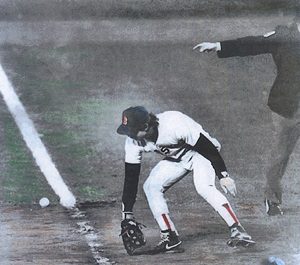
1986 – A routine ground ball went through Boston Red Sox first baseman Bill Buckner’s legs.
Trying for their first World Series title since 1918, the Red Sox led the New York Mets 5-3 going into the bottom of the 10th inning at Shea Stadium.
The Mets tied it with two outs, then Mookie Wilson hit a roller up the first base line that got past a hobbled Buckner, a misplay that let Ray Knight rush home from second base with the winning run.
The Red Sox lost 8-5 in Game 7, and their World Series drought continued until they won the championship in 2004.
Boston fans and media alike have forever questioned whether or not Dave Stapleton should have been in the game over Buckner. McNamara, after all, had been making that switch throughout the playoffs late in games.
Yet, he always stood by his decision to leave Buckner in during Game 6, and the former manager says it wasn’t a decision born out of sentimentality.
“Buckner was the best first baseman I had. And Dave Stapleton’s nickname was Shakey. And you know what that implies. I didn’t want him playing first base to end that game, and it was not any sentimental thing that I had for Billy.”
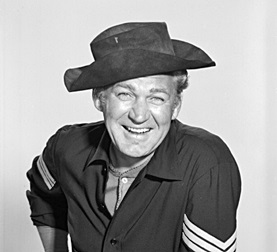
1986 – Actor Forrest Tucker died of cancer at the age of 67.
Although he appeared in more than 100 films – including Sands of Iwo Jima and Auntie Mame – in a motion-picture career that began in 1939 and spanned almost four decades, Tucker was best known for his role of Cavalry Sgt. Morgan O’Rourke in the comedy television series F Troop.
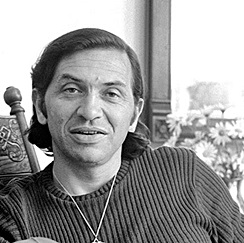
1991 – Music promoter Bill Graham was killed in a helicopter crash. He was 60.
Graham was returning home from a concert in Concord, CA when his helicopter, flying in severe weather, with rain and gusty winds, flew off course and slammed directly into a 223-foot high-voltage tower.
The helicopter burst into flames on impact, killing Graham, the pilot, and Graham’s girlfriend, Melissa Gold.
For 25 years, Graham – through his association with rock venues Fillmore West and Fillmore East – had been a monumental figure in the rock world. He was the most dominant character in the realm of rock concert production, the man who single-handedly ushered the field into the modern era.
He headed a music business empire that managed successful artists, produced a hit movie about the Doors, manufactured millions of dollars’ worth of T-shirts and sold $100 million worth of tickets to concerts annually.
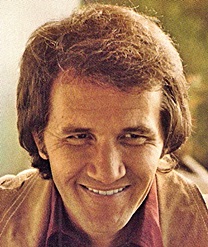
1992 – Singer/songwriter Roger Miller died of lung and throat cancer at the age of 56.
Miller recorded 20 singles that reached the Billboard Top 20 Country charts, and 12 that reached the Top 40 pop charts.
Among those hits were King Of The Road, Dang Me, Chug-a-Lug, England Swings, and One Dyin’ and a Buryin’.
Broadway Factoid: Miller wrote the music and lyrics for the 1985 Broadway musical Big River. He won a Tony Award for Best Original Score.
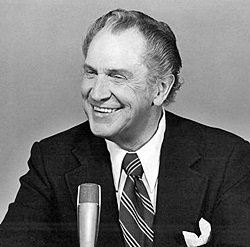
1993 – Actor Vincent Price died of lung cancer at the age of 82.
Before he become synonymous with horror films, Price’s first roles were in classic films such as Laura and The Song of Bernadette.
His big break came with House of Wax in 1953 (one of the first films shot in 3D). With this film he established himself as America’s master of horror, and he was instrumental in bringing back the genre’s popularity, performing in such films as The Fly, House on Haunted Hill, House of Usher, The Pit and The Pendulum, and The Abominable Dr. Phibes.
Outside the horror realm, Price played Baka (the master builder) in The Ten Commandments.
Price Factoids: Not one but three of them!
1) His grandfather was Vincent Clarence Price who invented Dr. Price’s Baking Powder, the first cream of tartar–based baking powder.
2) He was a descendant of Peregrine White, the first white child born in Colonial Massachusetts, being born on the Mayflower while it was in Provincetown Harbor.
3) In 1982, Price provided the spoken-word sequence – and the famous maniacal laugh – to the end of the Michael Jackson song Thriller.

1994 – Susan Smith of Union, SC, reported her car had been carjacked by a black man … with her two sons still inside.
For nine days, she made dramatic pleas on national television for their rescue and return.
However, following an intensive investigation and a nationwide search, she confessed on November 3 to letting her car roll down a steep ramp into John D. Long Lake, drowning 3-year old Michael and 4-month-old Alexander inside.
Divers returned to the lake where searches in the early days of the investigation had yielded no evidence of the young boys or a car.
Once the divers adjusted where they searched the murky waters by 10 feet further, roughly 120 feet from the shore line, they found the bodies of Michael and Alex submerged in 18 feet of water inside the car.
Michael was holding his little brother’s hand.
In July 1995, a jury rejected the prosecution’s request for the death penalty Judge William Howard sentenced Smith to thirty years to life in prison. She will be eligible for parole in November 2024. At that time, she will be 53 years old.
Tragedy Aftermath: The nightmare in Union, SC did not end with the murder of Smith’s sons.
In 1996, a group of 10 people from Buffalo, SC drove to the lake and parked next to the ramp, shining the headlights of the vehicle on memorials to the two Smith boys.
Five of the people had gotten out of the vehicle when it started to roll down the embankment, with four children and one adult still inside. The truck plunged into 15 feet of water, drowning everyone inside.
Two people outside the truck, including the wife and mother of four of the victims, went into the water to try to save them, and also drowned.

1999 – Golfer Payne Stewart died at the age of 42.
Stewart was killed in the crash of a Learjet flying from his home in Orlando to Texas for the year-ending tournament, The Tour Championship.
National Transportation Safety Board investigators concluded that the aircraft failed to pressurize and that all on board were incapacitated due to hypoxia as the aircraft passed to the west of Gainesville, Florida.
The aircraft continued flying on autopilot until it ran out of fuel and crashed into a field near Mina, South Dakota.
During his career, Stewart had 11 victories on the PGA tour, including 3 Major championships (the U.S. Open twice and the PGA Championship).
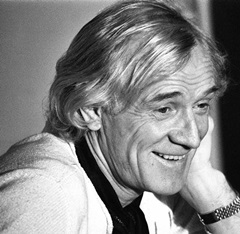
2002 – Actor/singer Richard Harris died of Hodgkin’s disease at the age of 72.
A two-time Academy Award nominee for Best Actor (This Sporting Life and The Field), Harris starred in Camelot (for which he won a Golden Globe Award for Best Actor) , A Man Called Horse, Major Dundee, Man In The Wilderness, Gladiator, and Unforgiven.
Later in life, he played the supporting role of Albus Dumbledore in the first two of the Harry Potter films. In a 2001 interview with David Letterman, Harris said he did not intend to take the part at first since he knew that his health was in decline, but he relented and accepted it because his 11-year-old granddaughter threatened never to speak to him again if he did not take it.
Someone Left The Cake Out In The Rain Factoid: Harris recorded several albums, one of which, A Tramp Shining, included the seven-minute hit song MacArthur Park which reached #2 on the American Billboard Hot 100 chart.
The song, written by Jimmy Webb, was first offered to The Association, whose members promptly rejected it because of its length, complex structure, and unorthodox lyrics. The band never had a Top 40 hit again.
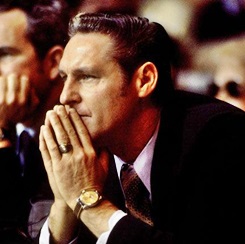
2013 – Basketball Hall of Fame player and coach Bill Sharman died following a stroke at the age of 87.
A sharpshooting guard who helped establish the Boston Celtics dynasty of the 1950s, Sharman finished in the top 10 in field goal percentage six times during his career and won the free throw title seven times.
As a coach, he led the 1971-72 Los Angeles Lakers to a record 33-game winning streak and the NBA title.
He was a 10-time NBA champion (four titles as a player with the Boston Celtics, one as head coach with the Lakers, and five as a Lakers executive).
Sharman was a two-time Basketball Hall of Fame inductee, having been being inducted in 1976 as a player, and in 2004 as a coach.
He Could Have Been A Baseball Hero Factoid: He was also an all-star in baseball, signing with the Brooklyn Dodgers organization and was on the Dodgers bench as a late-season call-up in 1951 when Bobby Thomson blasted the legendary home run at the Polo Grounds to lift the New York Giants to the National League championship.

2014 – Jack Bruce, the bassist and singer for the seminal 60s rock group Cream, died of liver disease at the age of 71.
In 1962, he joined Alexis Korner’s Blues Incorporated before joining drummer Ginger Baker – with whom he would have a lifelong contentious relationship – in the Graham Bond Organisation.
After brief stints with John Mayall’s Bluesbreakers and Manfred Mann, Bruce joined Baker and guitarist Eric Clapton in 1966 to form Cream, rock’s first “supergroup”.
Bruce was responsible, with co-writer Peter Brown, for writing the majority of the band’s songs. Their most famous hits include I Feel Free, White Room, Tales of Brave Ulysses, Politician and (with Clapton) Sunshine Of Your Love.
The antagonism between Bruce and Baker created constant tension in the band and Cream split up in 1968, with all three members pursuing various pursuits. The trio was inducted into the Rock and Roll Hall of Fame in 1993.
In 2003, Bruce was diagnosed with cancer, and underwent a liver transplant. Although his immune system initially rejected the organ, he recovered and was able to participate in a reunion of Cream two years later.
Together with Clapton and Baker, Bruce played four sold-out shows at the Royal Albert Hall in London, and three more at Madison Square Garden in New York City.
Compiled by Ray Lemire ©2019 RayLemire.com / Streamingoldies.com. All Rights Reserved.
Lots of important lessons here and the details make it feel like I was there! You are a Story Teller, in the good way! I have also never seen any Michael Myers’ Halloween movies and probably never will. I remember that World Series game! My first introduction to Vincent Price was The Pit and the Pendulum…gotta love those old movie marathons on channel 56! I sadly also remember the Susan Smith case….but I don’t think I knew about the aftermath….Thanks for keeping it real! 🙂
Thank you, Wendyl. ❤
Some days are “sadder” than others but while I find it difficult to bring those memories back into focus, I know it’s necessary because they are a part of out story.
so many events today that we should reflect on … impressed with the actions taken by JFK and Stevenson on the Cuban Missile Crisis – Clearly leaders who were willing to make the difficult decisions for our Country …. the travesty (in)justice in Alabama is (still) extremely difficult to imagine — I agree with the Halloween Series — I’m not adding that to my schedule either Ray … and I loved Richard Harris in Camelot — one of my all time favorite plays and movies …. remember when those two young boys died and can’t imagine why Susan Smith wasn’t given the death penalty – I didn’t realize a second tragedy occurred there involved even more children … this one was filled with so much Ray – even the Red Sox piece intrigued me …. thank you for another opportunity to reflect and learn ….
Thank you, Barbara.
The Red Sox victory aside, October 25 was, all things considered, a very horrible day.
p.s. I thought Richard Harris was a brilliant actor.